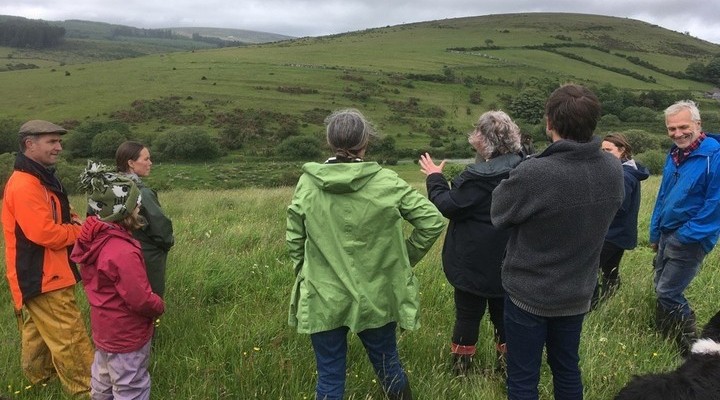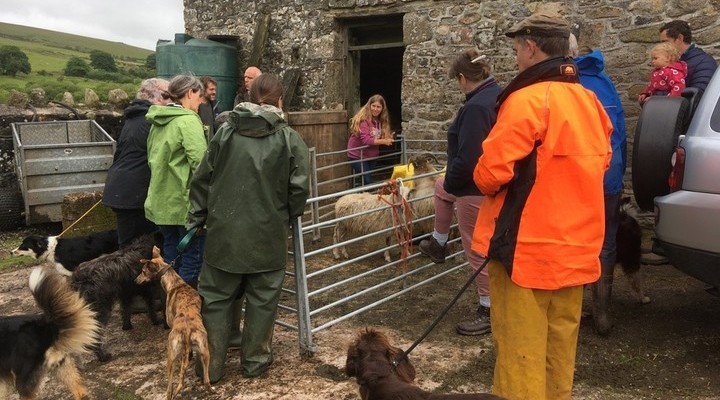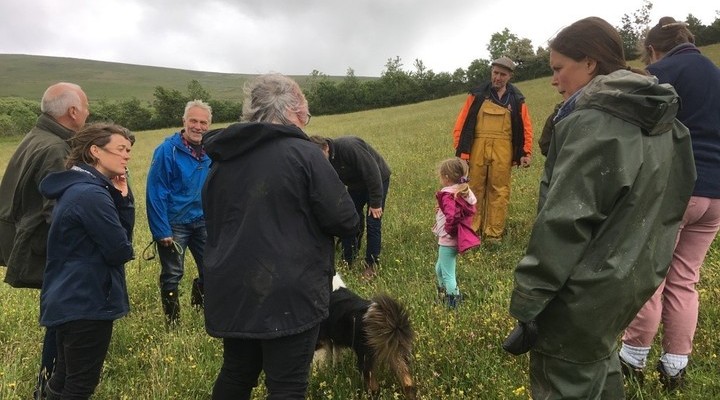Challacombe Farm Open Day

Naomi Oakley and Mark Owen at Challacombe Farm on Dartmoor held an open day on 16 June and took the opportunity to host an informal gathering of south west PFLA members. Challacombe has both its beef and sheep enterprises certified under Pasture for Life as well as being one of the first farms in the UK to be certified Animal Welfare Approved. The open day was to give people the chance to see the amazing upland hay meadows and rhos pastures and Naomi gave a guided tour.
Challacombe Farm consists of 190 hectares of severely disadvantaged permanent pasture land on Dartmoor, with rights to graze common land as well. The vast majority of the farm is designated as a scheduled ancient monument which severely restricts any activity that could disturb the soil – including putting in fence posts. The features leading to the designation include a large area of medieval strip lynchets – terraces in the hillside made where medieval farmers ploughed land that we would not even think of cultivating today.
There are also remains of tin mining – from small pits to larger workings – remnants of an industry that was important for hundreds of years. Additionally the remains of Challacombe medieval village are next to today’s farmhouse – a reminder of a time when hundreds of people made their living in this landscape. The farm is in Higher Level Stewardship supporting a range of environmental management – Naomi pointed out that this makes a huge contribution to this upland farm’s income. Even with this, both she and Mark have other jobs away from the farm.
After an introduction to the farm (and tea and cakes), the tour started in the yard where a few of the farm’s Icelandic sheep were on display.

Some of these are crossed with a Shetland ram and there are also a few Wensleydales and Zwartble sheep on the farm. The small Icelandic sheep do really well on Dartmoor and on a 100% pasture diet. This breed has the bonus of being the “rat tailed” type that does not need to be tail docked. They are slaughtered at around two years of age with meat sold direct from the farm. The meat tasted at the farm was incredibly flavourful and tender. Local spinners and artists also like the variety of colours in the Icelandic fleeces.
Naomi took the group to see the hay meadows. It was interesting to see the difference between the fields that have undergone many years of restoration and those that are still a work in progress. Gorse had to be cleared from these fields and green hay from local flower rich hay meadows was spread over multiple years. The best field had been dominated by gorse which was cleared and green hay was used to boost the seedbank, after eight years the majority of the vegetation is herbs and flowers with a small amount of grass species. A sole marsh orchid was looking slightly out of place but later in the season lesser butterfly orchids will thrive here. Seed from this field has been spread on the next field up the hill – and that was also looking beautiful with a huge variety of species. The third field is a work in progress and the dominance of grass species could be seen here. These fields are cut for hay in late July and lightly grazed with cattle until they get bored with it. By the end of August the fields are spread with Timac Humistart, a soil conditioner to increase microbial activity. Well-rotted and composted manure from winter housing is then applied.

The tour moved down the hill to the rhos pastures – these are species rich wet pastures with rushes and purple moor grass as well as the rarer species devils bit scabious and a lot more orchids. At Challacombe these pastures are home to Marsh Fritillary butterflies, narrow-bordered bee hawk-moth and a rare bog hoverfly. The action of cattle grazing creates the conditions these species require, which are very difficult to replicate without grazing.
The tour finished at the buildings. The cattle are never confined to housing, but through the winter have free access to wander in and out as they please. Cattle breeds include Welsh Black and North Devons. A few animals might be finished on farm for direct meat sales and most stores are sold through the local market. Manure from the winter period is stacked under cover and turned two or three times prior to being spread on the fields. Naomi can and does move the cattle round the farm, but they always have large areas so they have choice of where to go and what to eat. The younger breeding animals learn from the older members of the herd where particular plants will emerge at different times of year and where the best shelter from sun, wind, rain or snow can be found. There was a brief discussion about mob grazing and – aside from the fencing difficulties at Challacombe – how this would curtail these behaviours. There is no doubt that the system being run at Challacombe suits the animals and has the outcome of 100% pasture for life meat from what would otherwise be an unproductive landscape.
Many thanks to Naomi and Mark for hosting and feeding the guests and it is hoped this is the first of many South West farm visits for PFLA members.
Kindly written by Anna Heaton. PFLA Member from the South West.



